Langlois’ formulation is the denial of time: an idea of history not as something past, things having happened and remembered, but something entirely now, aggregated all together, present – meaning both presence and in the present tense. — Caroline Small
There was once a man; he had learned as a child that beautiful tale of how God tried Abraham, how he withstood the test, kept his faith and for the second time received a son against every expectation. When he became older he read the same story with even greater admiration, for life had divdied what had been united in the child’s pious simplicity. The older he became the more often his thoughts turned to that tale, his enthusiasm became stronger and stronger, and yet less and less could he understand it. Finally it put everything else out of his mind; his soul had but one wish, actually to see Abraham, and one longing, to have been witness to those events. — Kierkegaard, Fear and Trembling
R. Crumb’s illustrated Book of Genesis does precisely what Caroline Small and Kierkegaard ask of art and of faith. In Crumb’s literal reading, with its physicality, and its playful touches of cartoonishness, the Bible is transformed from a fusty, inaccessible monument to boredom and bewildering begats into “something new,” a text that makes the familiar alien, or, at least, more familiar. In giving flesh to the Biblical narrative, Crumb allows us to do what Kierkegaard, tragically lacking the technology of sequential pictograms, could not. We can “actually…see Abraham” drawn before us, and watch the flickers of agony, hope, love, and relief flow across his comfortingly craggy patriarchal visage, as if he were Patrick Stewart reacting with satisfying aplomb to the Romulan menace.
Moreover, Crumb penetrates to a truth that Caro and Kierkegaard fail, each in their own way, to understand. Making something new is best done, not through imaginative engagement, but through rote drudgery. Clichés are our deepest selves; to present them with minimal comment or inquiry is therefore the artist’s highest calling.
Pesky floating bearded heads — didn’t I spray for those?
You can tell I am remembering because I am pointing to my head!
You can tell I am listening because I am cupping my ear!
Why do we see God as a bearded patriarch? Crumb cunningly investigates and undermines this image through his steadfast refusal to investigate or undermine it. Deftly deploying the poverty of his visual imagination as well as a deep spiritual engagement, Crumb shows us a God daring in His vacuousness; a children’s book deity who pantomimes and points in case the kiddies can’t parse the text, yet who thoughtfully problematizes His own superficiality not through any actual ideas or initiative, but rather through the very fact of being in a big honking coffee table book by R. Crumb.
Crumb’s insistence on transcribing every word of Genesis without bowdlerization or omission again makes history new by bringing into focus many aspects of the narrative previously glossed over by Christian and secular readers alike. For example, Crumb shows us that women in the past had nipples. He also demonstrates that Adam had a penis, even if nobody else in particular did, (Update: Robert in comments points out that at least one other person in the book has a penis too.) and that when people are anxious, little sweat drops fly off of them.
And, of course, he provides visual referents for the begats.
Another artist, less versed in the transcendentally validating power of banality, might have attempted to visually integrate the passage’s obsessions with patriarchy, seed, age, and death. One can imagine Chris Ware, for example, creating a single intricate image of lineage, or Johnny Ryan (channelling the younger Crumb) treating the text as an opportunity to create an extended daisy chain of sentient semen. Far better Crumb’s vision — a series of small disconnected drawings of more or less random scenes of life, recalling a light television montage that gets up on its hind legs to say, “Humanity! How heartwarming!” Time passes, life passes, Crumb draws, and the strings swell. Crumb has commented in interviews on the strangeness of the Biblical narrative; what better way to emphasize that strangeness than to turn it into a drab sentimental parable?
Ng Suat Tong started this Genesis discussion off by comparing Crumb’s visuals to the efforts of great artists of the past. Of course, it is not really cricket to put Crumb next to artists like Blake since Crumb draws lots of pictures on a page, thus obviously quantitatively overwhelming painters who only drew one at a time. Similarly, it seems unfair to place Crumb beside mere authors since mathematically: pictures + words> words. Still, I think it’s worth looking at this passage by Kierkegaard to show exactly what Biblical exegesis has been missing up to this moment.
It was early morning. Abraham rose in good time, had the asses saddled and left his tent, taking Isaac with him, but Sarah watched them from the window as they went down the valley until she could see them no more. They rode in silence for three days; on the morning of the fourth Abraham still said not a word, but raised his eyes and saw afar the mountain in Moriah. He left the lads behind and went on alone up the mountain with Isaac beside him. But Abraham said to himself” “I won’t conceal from Isaac where this way is leading him.” He stood still, laid his hand on Isaac’s head to give him his blessing, and Isaac bent down to receive it. And Abraham’s expression was fatherly, his gaze gentle, his speech encouraging. But Isaac could not understand him, his soul could not be uplifted; he clung to Abraham’s knees, pleaded at his feet, begged for his young life, for his fair promise; he called to mind the joy in Abraham’s house, reminded him of the sorrow and loneliness. Then Abraham lifted the boy up and walked with him, taking him by the hand, and his words were full of comfort and exhortation. But Isaac could not understand him. Then he turned away from Isaac for a moment, but when Isaac saw his face for a second time it was changed, his gaze was wild, his mien one of horror. He caught Isaac by the chest, threw him to the ground and said: “Foolish boy,, do you believe I am your father? I am an idolater. Do you believe this is God’s command? No, it is my own desire.” Then Isaac trembled and in his anguish cried” “God in heaven have mercy on me, God of Abraham have mercy on me; if I have no father on earth, then be Thou my father!” But below his breath Abraham said to himself: “Lord in heaven I thank Thee; it is after all better that he believe I am a monster than that he lose faith in Thee.”
Kierkegaard uses the story as the occasion for an inquiry into faith and love between God and man, father and son. He does this by treating the story as his own; it is a coat that he can put on, adjust, take in or let out. For him, reverence involves dispensing with reverence; to understand the story of Abraham as it is, he has to defile it with his own imagination.
Crumb, on the other hand, treats the story as an inquiry into the story. It is his job to clothe the text, not to have the text clothe him. You can see him doing his best to provide a striking garment; Abraham looks grimly determined here, sweatily panicked there, movingly relieved in the center panel of the second page (perhaps the strongest single image in the book, despite the yep-there-it-is-again light from heaven.) But this is gilding, not defilement. Kierkegaard fucks with Genesis and ends up begatting a new creation; Crumb puts a few ribbons of varying construction in the text’s hair and sends it on its way.
And, surely, this is the great contribution of comics to Biblical criticism and to art. Without much of a tradition of accomplishment, sequential pictographs are perfectly situated for the aesthetic task of the future — namely to rehash what has gone before as doggedly and unimaginatively as possible. Perhaps Caro was wrong after all; the best way to deny time is not to recast the past as present, but the present as past. Nothing has happened, no one has spoken, neither God nor our ancestors have taught us anything, and so the most lackluster retread deserves the most heartfelt hosannahs. If defilement is reverence, then reverence is the truest defilement —both of the Bible and of art, which are cast together, through the power of Crumb’s genius, out of the flawed garden of giving a shit and into the absolute purity of irrelevance.
_____________________
For a less gratuitously mean-spirited take on R. Crumb’s Genesis, I’d urge folks to read the heartfelt and thoughtful defenses by Alan Choate andKen Parille. The entire ongoing back and forth about Genesis on this blog can be found here.

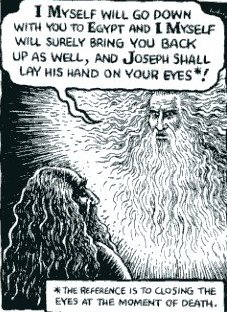
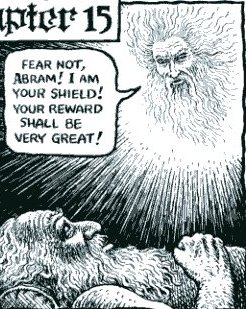


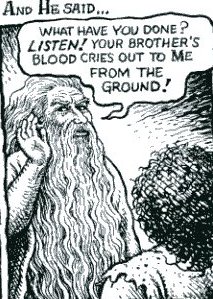
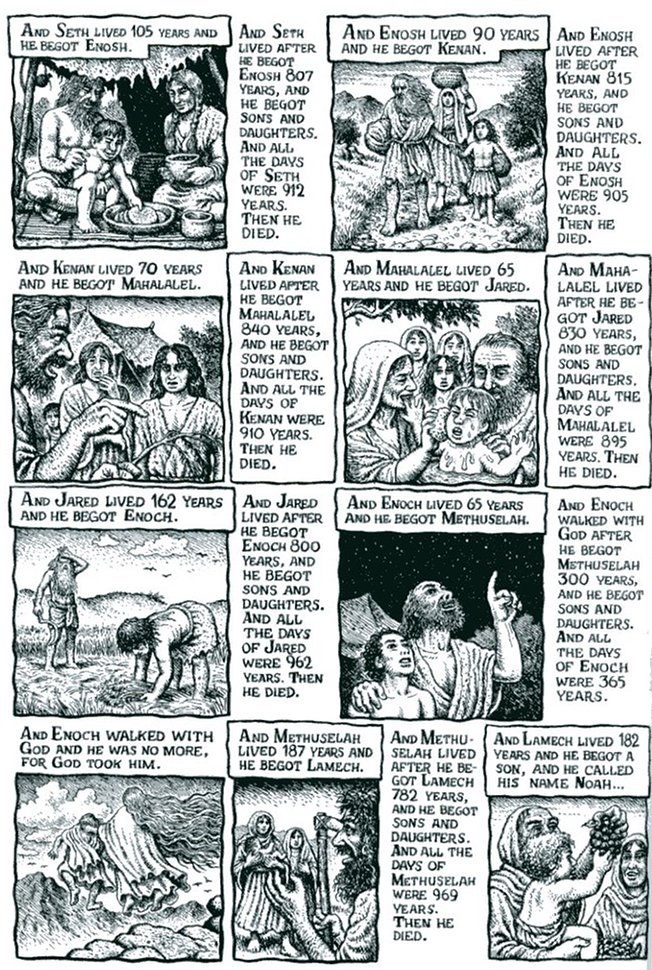

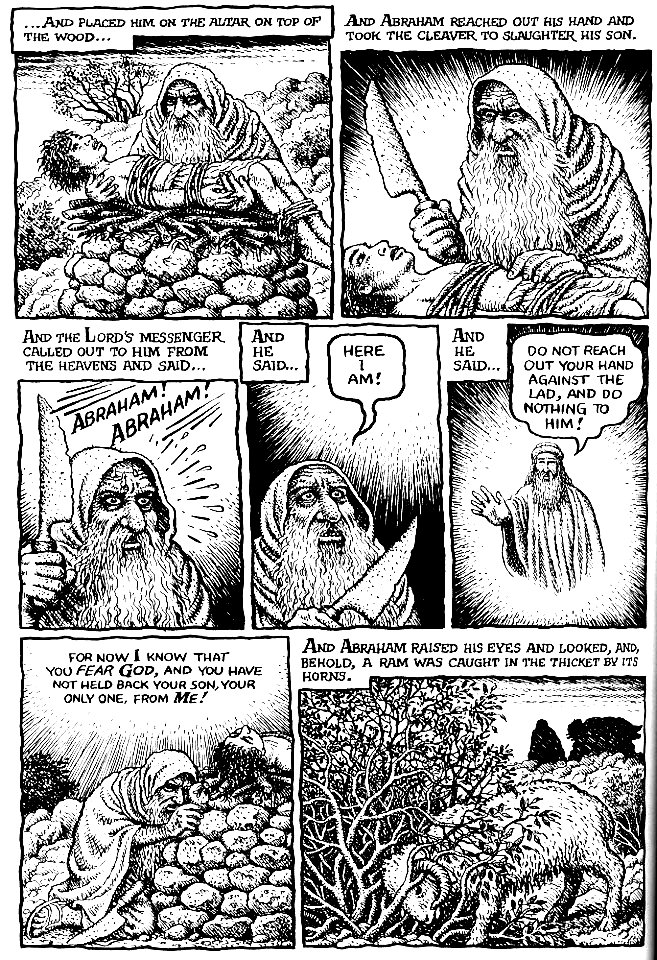
As you no doubt know, Noah, I couldn’t agree more. However, we need more gratuitously mean-spirited takes on this piece of middlebrow sludge.
By the way, just so Jeet Heer can move on to complain about more substantial things, I should highlight a couple of obvious errors. One, Michelangelo portrayed Adam with a penis, so your claim that “nobody else in particular” besides Crumb has done so is false. Two, many artists have depicted Eve with nipples, including fig-leaf popularizers like Rubens and Durer.
Just thought I should keep you on your toes.
Robert, you are willfully misrepresenting my intentions. Shame, sir! Shame! Shame!
If you were a careful and honest reader, you would see that I was clearly saying that Crumb failed to represent anyone else with penises. That is, in his book, only Adam has one — “nobody else in particular” does.
And, yeah, I knew that various artists have given Adam a penis and Eve nipples. I was trying to throw Crumb a bone (though that’s probably not the best metaphor there, come to think of it.)
But, but, Crumb depicts Noah with a penis in the scene where he gets drunk. It’s one of the great achievements of the book, in which Crumb slyly and subversively identifies with the disrespectful Ham by showing us what he sees.
Oh, darn it. I missed a penis. I hate it when that happens. I’ll put in a correction.
I’m a little confused why Isaac looks like Frodo. And that would make Abraham … Gandalf?
Maybe there’s more meaning to this book then you think, Noah.
That’s some grade-A sneer right there.
They are going to the mountain of Moria (if you’re willing to drop the “h”.)
I suck like Kierkegaard! Score!
This is a really funny piece.
But this bit is a pretty good summation of its limitations, all joking aside:
I’m just still not satisfied with the defenses that I’ve heard for this choice…they all seem to be variously implying either that he actually does “have the text clothe him,” which doesn’t seem right, or that it’s ok for him to clothe the text, which just seems pedestrian. OK, certainly, but pedestrian.
I actually think it’s a really lovely book; flipping through it without reading is a much better experience for me than you, Noah — I’m have not been a big fan of Crumb’s art but this book is very pleasing to look at and I think that after reading it I may be able to get more out of earlier Crumb. But still, I just don’t see the oomph…when I actually dig in and read, I just think it’s kind of dull.
Naomi, are you related to Miriam? If so, say hi to her for me, could you? We miss her around here!
There’s definitely a lot of lovely drawing, as in anything by Crumb. I find a lot of his tics kind of annoying at this point, which limits my pleasure somewhat…but yeah, his talent is undeniable. That drawing of Abraham I pointed out is beautiful…even if he is Gandalf.
That’s a funny post, Noah.
I’d have no problem with your criticism if it were just based on your personal taste – but your implication that Crumb doesn’t know he’s using clichés seems wrong to me.
It’s not that I’m a huge fan of the extreme pantomime gestures in Crumb’s (or even Will Eisner’s work) – but I don’t think it’s a lack of imagination that draws them to that approach. Like it or not, I think it’s a deliberately considered choice that’s come by honestly. Cartooning in it’s purest form involves cliché and exaggeration – again, like it or not – I think that was one of the points of this book.
Aaron — I took the jabs as being at critics rather than at Crumb himself — that said, your idea that the cliche and exaggeration is inherent to the form is actually the best defense of these choices that I’ve heard. (Finally, we’re getting somewhere.)
I’m not sure I think that the association of cliche and exaggeration with cartooning past makes it a good thing for cartooning present, though…isn’t it time to move past that, maybe?
Noah, I enjoy your snark, as always. Nonetheless I think you should join a 12-step program against bad faith.
A theatrically gesturing God? Such a horror! But perfectly in line with a Mediterranean people such as the Hebrews; just thank G…, er, thank Someone that YHVH wasn’t Italian.
The Isaac sequence seems perfectly interprzeted by Crumb. GOD TOLD HIM TO KILL HIS KID. What sort of emotions do you think Abraham should feel and express at the climax of this test? Serenity? Boredom?
The only reproach I can muster against this scene is that most Biblical exegetes agree that Isaac was a grown man at the time.
Tsk, tsk, as God said just before that regrettable Sodom incident where no weapons of mass blasphemy (WMB’s) were actually found.
Caro: “…that said, your idea that the cliche and exaggeration is inherent to the form is actually the best defense of these choices that I’ve heard.”
This sounds like one of Domingos’ pet peeves. A thermonuclear attack on this idea from that side of the pond to be expected soon…
Hey Alex. I wish the gesturing read as more clearly Jewish, or that God did in general (why not put him in a yamaka?) It just comes off as lazy and simple-minded to me; Crumb drawing the only sort of action he can think of, because he’s not especially inventive and has to draw something.
I’m not horrified by it. I’m bored.
As for Isaac and Abraham; the point is that Kierkegaard uses the scene to think through what the text says in various ways. (He actually has a series of different imaginations of the scene; it’s a remarkable sequence.) It’s not that what Crumb says is wrong; it’s that I don’t see how it adds much if anything to what I could get from the text. On the contrary, the strained dramatic pantomime of it starts to tip over into farce — as Richard pointed out in his Gandalf/Frodo comparison.
And no, I don’t think Crumb is subtly undermining the Abraham story by linking Abraham to Gandalf. I think he just has a very limited range of ideas at his command.
And the idea that comics has to rely on cliche and stereotypes… (a) that’s just depressing, and (b) if he wanted to do farce, he should have fucking done farce. If you’re going to say something, say it. Don’t tip toe around the text and then expect us all to interpret your inarticulateness as subtlety.
Caro said: “I’m not sure I think that the association of cliche and exaggeration with cartooning past makes it a good thing for cartooning present, though…isn’t it time to move past that, maybe?”
That’s not a bad point – but it really depends on what the artist is going for. Crumb’s whole thing is wrapped in his obsession with old cartoons, so criticizing him for it seems kind of moot to me. It’s like saying ‘Crumb would be better if he wasn’t Crumb’.
I don’t care about criticizing Crumb – especially if the criticism is valid – he’s no sacred cow to me. My problem is you could dismiss hundreds of other artists with the same criticism: ” Schulz always draws Charlie Brown the same way when he gets frustrated – he’s not very creative”
Cartoonists develop and employ their own short-hand and use of cliché – it’s part of the craft. You may enjoy more a more nuanced and realistic approach to comics – that’s totally fine and you can find lots of those – but comics that employ cartooning is a different deal. To me anyway.
Noah – (a) sorry, now I’m not being very articulate. I’m not suggesting that a cartoonist approach to comics is the way ALL comics should work.
(b) I don’t think Crumb’s going for farce just because he’s using cartoons. I think he’s established a cartoon style and his own short-hand language of comics and he wanted to use some unconventional material with it.
Does Crumb even care if the mix of cartooning and the bible even makes sense as a finished product? Personally I don’t think so. If anything I get the idea that his motive is to use association through cartooning to analyze what he thinks about things because he’s a huge narcissist. Which is what (sometimes) makes his work interesting to me – apart from his drawing skills.
Schulz’s style is I’d argue very appropriate for what he’s doing with it, and for his aesthetic. His approach is minimalist, which is tied into the strip’s humor and pathos. There are repetitive, almost ritualist elements in his work too, which are idiosyncratic. He isn’t actually relying on outside cliche; he’s created his own memes, and uses them repetitively for aesthetic affect.
I would argue that that is very different from taking generalized cliches and retailing them without either comment or insight. You’ll notice I didn’t make fun of Crumb for drawing standard Crumb women. I made fun of him for his egregiously lame decision to show God over and over again as a floating bearded head, and for his apparent inability to actually do anything thematically, intellectually, or, yes, aesthetically interesting with one of the foundation texts of Western civilization.
The whole thing is like watching an inept comedian execute a half-assed pratfall.
“Does Crumb even care if the mix of cartooning and the bible even makes sense as a finished product? Personally I don’t think so.”
Maybe not. But if he doesn’t care, it’s really unclear to me why I should.
Sorry, Aaron. This book makes me cranky.
I think one thing your comment gets at is sort of something I’ve been thinking about with Crumb too. That is, his work in general, and this project in particular, seems divorced from what we usually think of as artistic motivation; there’s an obsessiveness to illustrating every line in Genesis that seems to in a lot of ways be its own point. He’s illustrating Genesis because that’s what he’s doing; the various efforts to claim the value of literalness both by him and by his critics seem almost beside the point.
There’s a definite sense in which Crumb fits into the category of outsider artist in terms of how he approaches his work and what it seems to mean to him (as far as anyone who is not him can figure that out.) The difference between him and folks who are usually categorized as “outsider” is that he doesn’t actually have the kind of vision usually associated with those artists…or if he does (as with the matriarchal take on the Bible) he’s chary about exploring it fully (at least recently.) He has compulsion and he has great talent, but his ideas tend to be really pedestrian (or at least so they seem to me) drawing their energy mostly from stereotypes, lust, and a fairly puerile cynicism. And I guess from an obsession with authenticity — but that’s so ingrained in our culture I hardly know if it qualifies as a defining characteristic….
Some of Crumb’s early work, at least, has a political/social angle to it. (One of my favorite ones is when Crumb is visited, in a dream, by Chairman Mao). The further he gets from that (into narcissism/solipsism) the less interesting his work is as art (although it sometimes has some psychological interest). Now he seems to want to move away from even that–into straight illustration jobs. So…basically, we can admire his draftsmanship, but this is not Crumb’s “artistic vision” in any meaningful sense. He’s drawing pictures to match words. The attempt to critically make this meaningful merely comes from the image of Crumb as “artist” and as “sacred cow.”
Noah, have you read The Gift Of Death (Derrida)—Pretty interesting take on the Abraham/Isaac story (I think, via Kierkegaard, as well as other commentators).
On the Schulz thing: it also seems to me that Schulz’s point is more than the drawing, the characters are his and the stories and whatnot.
If Crumb had actually written the Bible stories he’s illutrating, we’d probably be having a different conversation here. There’s a problem of “added value” for an illustration work that Schulz doesn’t have…
The repetition of visuals doesn’t bother me; the repetition of composition bothers me a little bit. But I’m overall ok with the execution; it’s the “why do this project?” that’s got be bewildered.
I’m waiting for Portugal to launch, Suat. :) (I probably won’t disagree with Domingos, but still, the “cartooning history” argument is at least more coherent than the “this is a contribution to Biblical scholarship and exegesis” one…)
Also, re: “drawing energy from stereotypes, lust and cynicism,” I don’t get lust out of this rendition, particularly. There’s a lot of sex, but it’s very…well, matter of fact.
I guess you could describe that as “lust rather than passion”, but isn’t that semantics? I guess I’m saying this is not a particularly erotic treatment, just an explicit one.
Congrats, I laughed so hard I blew meatballs out my nose.
Eric, I actually just finished the Gift of Death. There are a lot of interesting readings, though his overall points I’m not super on board with (he sort of turns the Abraham/Isaac story into an exemplar of universal liberal guilt in a way that I think is kind of dumb.) Anyway, I’m working on an essay about it and Kierkegaard and education and art for this arts magazine; it’ll probably take a while, but I’ll post it here one of these days.
Caro, I’d agree that Crumb doesn’t really make any strong decisions in Genesis, erotic or otherwise. Still…the scene where Isaac and Rebekah are in the act is one of the panels in the book that has some real feeling behind it, I thought…and his pictures of women are always erotically charged, for better or worse. There’s an erotic Crumb Genesis that could work; again, this just isn’t that.
James, I hope your nose heals!
“universal liberal guilt”–I’m not sure I got that out of it….I had different bones to pick, I expect…
Congrats Noah! You’re the first human to accuse Derrida of dumbness!…
Caro and Suat: Besides agreeing with Caro, as usual, I really don’t want to discuss this book.
It simply didn’t grab my interest one way or the other…
The last book in which Crumb’s chops as a draftsman really impressed me was _Art & Beauty_. Indeed!… It was one of those instances in which virtuosity almost reaches the status of great art. (And I’m saying this as someone who really hates virtuosos.)
“Literalness”…?
Fiore, what have you done to Noah !?!
He fed me into that author identifier and turned me into H.P. Lovecraft, right?
Oddly, Noah, it’s exactly all the elements you scorn here that made Crumb’s Genesis work for me: the sense not of glory and majesty but of generations wallowing in the dirt, with the mannerisms of Borscht Belt dinner theater. It’s that contrast of the utterly mundane against the text’s uninterpreted obsession with piety and the presumption of divine right by its players that brings home the sad comedy of the whole thing, not to mention the telling repetitions of its plot, and it’s hard to believe that was not his specific intention. I don’t doubt Crumb could’ve been much more imaginative in his transliteration. I’m just unconvinced that, in this case, more imagination would’ve accomplished anything worth mentioning.
Hey Steven. That’s an interesting take, and I think a well-expressed explanation of what it seems like others have found in the book. I guess my problem is that I feel like lack of imagination doesn’t actually do what you’re claiming for it. That is, I didn’t get sad comedy, so much as incompetent comedy (or incompetent sadness.)
Or to put it another way: I don’t think mundane and cliched are synonyms; nor are mundane and half-assed. There’s nothing especially mundane about a floating bearded head, or about a great light in the sky. Crumb could have emphasized mundanity in various ways (he could have done a lot more to suggest that God might not exist, for example.) He could have done more to emphasize textual repetition too, or even the passage of time as a weight. I just feel like abdicating decision doesn’t turn out, for me, to be a useful or moving aesthetic decision.
Well, consider Crumb’s various adaptations from literature. For instance, Boswell ( http://comppile.org/comppanels/comppanel_13.htm ), “Psychopathia Sexualis,” the works of Kafka.
Does Crumb simply use the original as a framework from which to take off from, or does he do an adaptation as reasonably faithful to the original as the medium (and page-count) allows?
Even with a source as outré as “The Religious Experience of Philip K. Dick,” Crumb – while hardly sharing Dick’s bizarre beliefs – does not satirically mock them, but depicts it as if he took all at “face value.”
Rather than a failure of imagination, Crumb might believe that the particular qualities of the original works (in all cases, hardly throwaway pieces) are better served and preserved by a straightforward translation into comics form, rather than “wink-wink-nudge-nudge” mockery, a distancing usage of aesthetic effects (“I’ll show God as the word, “God”! Or, maybe a set of geometric symbols…”), etc.
Crumb can’t really be faulted for not suggesting via his interpretation that God doesn’t exist, since his goal was to do an “uninterpreted” (though, obviously, just visualizing text is interpretation) Genesis and God is a significant player presented as a real presence. Certainly filtering Genesis through the presumption that Yahweh is simply some sort of mass delusion would be an interesting project – sort of a high end Garfield Without Garfield – but that wasn’t Crumb’s goal.
As I said, the book worked for me, but I can understand why you and others might feel otherwise and I don’t think much of what you say is necessarily inaccurate, though, as I said, I’m not sure portraying the Biblical God as anything other than a father figure with flowing white tresses would’ve accomplished anything in context. (I do have to admit I found the portrayal laughable, but what other options? A three-headed serpent? A ball of light? A burning bush? David Bowie?) To some extent I find that aspect of the criticism on par with the now much-repeated criticism of Inception that the film’s dream world sequences weren’t “dream-like” enough. But they weren’t intended to be, and would it have been a better movie had they been?